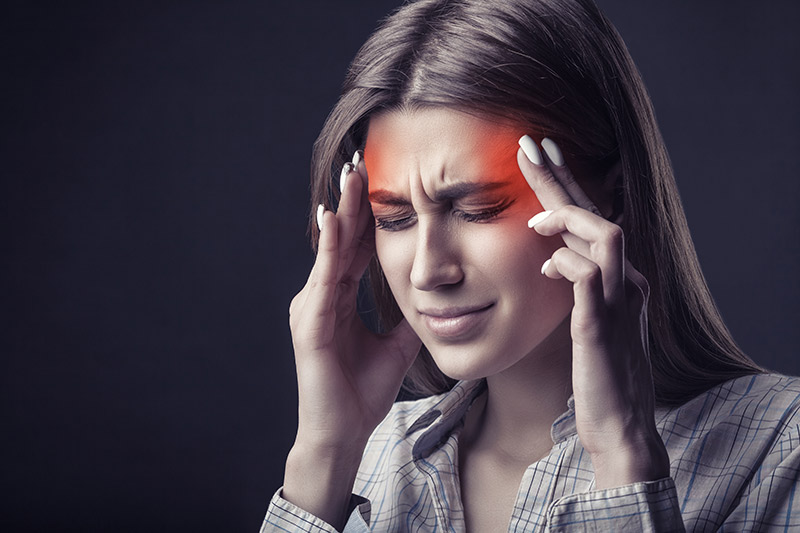
Not all headaches are created equally. Oftentimes, headaches can really ruin your day. If they become more persistent, intense or unbearable then you might need extra help solving the problem. Here are just a few different types of head pain and how to treat them.
1. Migraines
A severe throbbing sensation felt on one side of your head (left or right) is the first sign you have a migraine. Often it is coupled with nausea, vomiting, and extreme sensitivity to light and sound. With a million reasons why they could be occurring, they are indeed tough to maneuver through and manage.
For some people, they know they are about to have a migraine when they experience an aura. An aura is a visual symptom of the migraine that could include the following:
- A visual phenomena, such as seeing various shapes, bright spots or flashes of light.
- Loss of vision
- Pins and needles sensations in an arm or leg
- Weakness or numbness in the face or one side of the body
- Difficulty speaking
- Hearing noises or music
Treatment for migraines usually consists of immediately resting in a quiet, dark room. When they become more frequent, seeking out medical help is the right course of action. It is important to track them so your healthcare provider understands the frequency and severity of your pain.
2. Tension Headache
If you are experiencing the sensation of a tight band wrapped around your head, then you might have a tension headache. It can also be described as squeezing pressure or aching pain that is mild to moderate in severity. Tension headaches can sometimes be confused with migraines, especially if you are experiencing them often.
Tension headaches can be the result of eye strain, excessive smoking, stress, anxiety, fatigue, TMJ, depression or head injury among other things. Many people report relief after taking over-the-counter medications like NSAIDs or acetaminophen.
3. Sinus Migraine
When the pressure is building up around your eyes and cheeks, and the pain gets worse as you bend over or lie down. Perhaps you have a stuffy nose, are fatigued or feel achy in your upper teeth. These are the signs of a sinus migraine. However, they can be easily confused with a regular migraine.
For the most part, sinus migraines do not come with the added bonus of nausea, vomiting or sensitivity to light and sound. Typically, a sinus migraine coincides with a viral infection or a cold.
It is time to see your healthcare provider when your symptomes are lasting more than 15 days in a given month or you are taking over-the-counter pain medications more frequently. Also, if you are missing out on school or work more often, then it is time to seek attention to your migraine troubles.
4. Thunderclap Headache
A lightning strike feeling to your head is exactly what a thunderclap headache feels like. These headaches are intense, but are typically short and only last for 5 minutes or so. The important thing to remember here is that they can be life-threatening. These headaches can be related to bleeding around the brain, blood clot or infection.
Additionally, thunderclap headaches can be accompanied by nausea, vomiting, altered mental state, fever and seizures. It is important to be seen right away if you experience this type of headache.
5. Cluster Headache
A hard poking sensation felt behind the eye is the typical result of a cluster headache. Many people report getting them seasonally and can occur everyday for weeks at a time. There is a nerve in your face that is affected, thus causing the severe pain you feel behind your eye. While the attack of a cluster headache can feel like the worst pain of your life, they typically do not last very long.
There are more symptoms that go along with cluster headaches. These include: mild burning sensation, swollen or drooping eye, eye redness, watery eye, runny nose, sweating, red/warm face and sensitivity to light.
6. Allergy Headache
As expected, allergy headaches are typically seasonal and follow in-line with a runny nose, sneezing and watery eyes. They can be caused by things like hay fever, food allergies and histamines.
The best way to avoid an allergy headache is to know your triggers and avoid them. When you are unable, be sure to have over-the-counter medications or prescription antihistamines and decongestants on hand.
How Can Summa Pain Care in Scottsdale Help?
Are you dealing with migraines or headaches? Are they becoming more intense or frequent? If so, you are not alone. Summa Pain Care helps patients treat and manage headaches and migraines. You can receive help too. Call today, (623)776-8686.
Comments are closed.
